jaime-dunaway-seale
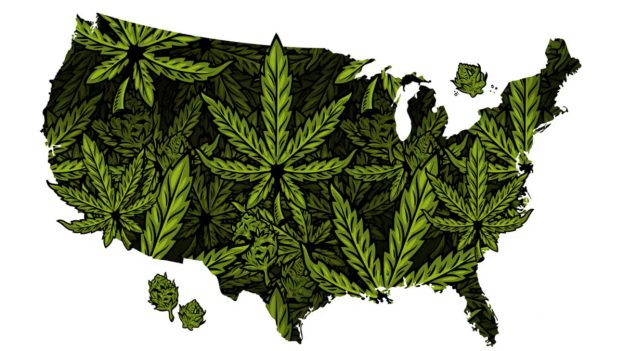

We Found the Best Weed Cities in the U.S. (2022 Data)
April 13, 2022 in Business, Cannabis Inspired, Today In Weed, Weed
When Colorado and Washington first legalized recreational marijuana in 2012, just 45% of Americans supported the measure. Today, public opinion has changed — 91% of Americans believe marijuana should be legal in some form, with 60% saying it should be legal for recreational use.
The “green wave” of public support has prompted 35 states to legalize weed for medical use, with 18 states and the District of Columbia giving residents the green light to smoke for recreational purposes. As legal markets expand, the marijuana industry has grown rapidly.
If it seemed like weed was as essential as toilet paper during the pandemic, you’re not high. More than 20 governors thought so, too, and deemed marijuana businesses essential. In 2020, the industry netted $13.4 billion, a number expected to increase to $33.6 billion by 2025.
Americans are consuming more cannabis than ever before, and tourists are flocking to mature and emerging markets for weed-infused experiences. To determine the best cities for stoners, we analyzed publicly available data from the U.S. Census Bureau, Bureau of Labor Statistics, Bureau of Economic Analysis, Google Trends, Price of Weed, DISA Global Solutions, and Yelp.
Our weighted rankings evaluated various criteria, including:
- 30x: Legality of marijuana
- 10x: Google Trends data for 13 common marijuana search terms
- 9x: Price of 1 ounce of high-quality marijuana and 1 ounce of medium-quality marijuana every three months as a percentage of annual income
- 9x: Price of 1 ounce of high-quality weed
- 8x: Price of 1 ounce of medium-quality weed
- 7x: Number of dispensaries per 100,000 residents within 25 miles
- 7x: Number of head shops per 100,000 residents within 25 miles
- 4x: Number of Taco Bells per 100,000 residents
- 1x (each): Music festivals within a 100-mile radius, small concert venues per 100,000 residents, movie theaters per 100,000 residents, and number of local hiking trails according to the AllTrails database
Read on to learn if your city is flying high — or living in the stone(d) age.
Weed City Statistics
- Denver is the best city for stoners with 7x more dispensaries (9.8 dispensaries per 100,000 residents) than the average city on our list (1.4).
- Las Vegas has the most head shops with 2.5 per 100,000 residents. That’s 212% more than the average city on our list (0.8).
- Our top 15 cities have 2x as many dispensaries (3.2 per 100,000 residents) as the average city on our list (1.4), making marijuana easier to find.
- Weed is also more affordable in our top cities, with 1 ounce of high-quality marijuana costing $274, about 14% less than the average price ($318).
- The best weed cities are concentrated on the West Coast, with the Golden State boasting six cities in the top 15.
- Sacramento, Calif., has the least expensive weed prices of all 50 cities studied.
- One ounce of high-quality weed ($212) costs $106 less than the national average ($318), and 1 ounce of medium-quality weed ($177) costs $76 less than the national average ($253).
- San Jose, Calif., residents spend just 1.6% of their annual income on marijuana, making it the most affordable weed city on our list.
- Although marijuana is only legal for medicinal use in Oklahoma, Oklahoma City ranks No. 1 for “pot passion.” Those residents search for marijuana-related terms on Google 117% more than the national average.
- Kansas City stoners won’t go hungry with 3.8 Taco Bells per 100,000 residents. That’s 65% more than the average city (2.3).
- Overall, the bottom 10 cities have 88% fewer dispensaries (0.6 per 100,000 residents) and 28% fewer head shops (0.2 per 100,000 residents) than the average city.
- Although marijuana is fully legal in Washington, D.C., it is the worst city for stoners because of high prices — 1 ounce of high-quality weed costs $597, about 88% more than the national average ($318).
- Average consumers spend about 3.7% of their annual income on weed, but D.C. residents spend 54% more than that — 5.8%.
The 50 Best Weed Cities, Ranked
The Best (and Worst) Weed Cities in 2022
| Rank | City | Legal Status | High-Quality Weed Price / 1 Oz | Annual Cost of Monthly Oz | % of Income Spent on Weed | Dispensaries / 100K Residents | Taco Bells / 100K Residents | Head Shops / 100K Residents |
| 1 | Denver, CO | Legalized | $242 | $2,906 | 2.59% | 9.8 | 2.6 | 2.2 |
| 2 | Portland, OR | Legalized | $213 | $2,557 | 2.61% | 7.9 | 2.5 | 1.1 |
| 3 | Sacramento, CA | Legalized | $212 | $2,542 | 2.51% | 4.5 | 3.2 | 1.1 |
| 4 | Las Vegas, NV | Legalized | $279 | $3,352 | 4.09% | 4 | 2.5 | 2.5 |
| 5 | San Jose, CA | Legalized | $245 | $2,942 | 1.60% | 4.4 | 2 | 1.7 |
| 6 | Seattle, WA | Legalized | $248 | $2,974 | 2.23% | 1.9 | 1.5 | 0.4 |
| 7 | San Francisco, CA | Legalized | $281 | $3,366 | 1.66% | 4.1 | 1.7 | 0.5 |
| 8 | San Diego, CA | Legalized | $270 | $3,239 | 3.08% | 3.1 | 1.5 | 1.5 |
| 9 | Los Angeles, CA | Legalized | $295 | $3,541 | 3.07% | 3.3 | 1.8 | 0.8 |
| 10 | Phoenix, AZ | Legalized | $292 | $3,507 | 4.06% | 1.2 | 2.5 | 0.3 |
| 11 | Virginia Beach, VA | Legalized | $329 | $3,944 | 4.33% | 0.1 | 3.4 | 1.3 |
| 12 | Riverside, CA | Legalized | $260 | $3,115 | 4.36% | 1.8 | 2 | 0.5 |
| 13 | Hartford, CT | Legalized | $315 | $3,775 | 3.42% | 0.6 | 1.7 | 1.6 |
| 14 | Detroit, MI | Legalized | $294 | $3,529 | 3.63% | 0.8 | 3 | 0.1 |
| 15 | Chicago, IL | Legalized | $343 | $4,119 | 3.76% | 0.3 | 2 | 0.4 |
| 16 | Boston, MA | Legalized | $338 | $4,054 | 2.87% | 0.9 | 0.8 | 0.7 |
| 17 | Buffalo, NY | Legalized | $318 | $3,818 | 4.20% | 0.4 | 0.9 | 0.8 |
| 18 | Richmond, VA | Legalized | $355 | $4,258 | 4.14% | 0.1 | 2.4 | 0.5 |
| 19 | New York, NY | Legalized | $381 | $4,568 | 3.26% | 0.4 | 1.1 | 0.4 |
| 20 | Oklahoma City, OK | Medicinal | $337 | $4,043 | 4.52% | 7.4 | 3.3 | 0.8 |
| 21 | Kansas City, MO | Medicinal, Decriminalized | $334 | $4,009 | 3.94% | 0.5 | 3.8 | 0.4 |
| 22 | Providence, RI | Medicinal, Decriminalized | $310 | $3,723 | 3.75% | 0.7 | 1.5 | 0.9 |
| 23 | Cincinnati, OH | Medicinal, Decriminalized | $343 | $4,111 | 3.78% | 0.4 | 2.8 | 0.7 |
| 24 | Cleveland, OH | Medicinal, Decriminalized | $338 | $4,056 | 3.91% | 0.5 | 2.6 | 0.5 |
| 25 | Baltimore, MD | Medicinal, Decriminalized | $330 | $3,964 | 3.53% | 1.3 | 1.4 | 0.6 |
| 26 | Columbus, OH | Medicinal, Decriminalized | $336 | $4,038 | 4.21% | 0.4 | 2.9 | 0.6 |
| 27 | New Orleans, LA | Medicinal, Decriminalized | $335 | $4,017 | 4.30% | 0.8 | 2.6 | 0.8 |
| 28 | St. Louis, MO | Medicinal, Decriminalized | $358 | $4,301 | 4.31% | 0.2 | 3.2 | 0.4 |
| 29 | Minneapolis, MN | Medicinal, Decriminalized | $330 | $3,956 | 3.55% | 0.2 | 1.7 | 0.5 |
| 30 | Salt Lake City, UT | Medicinal | $280 | $3,359 | 3.55% | 0.5 | 1.8 | 1 |
| 31 | Orlando, FL | Medicinal | $305 | $3,664 | 4.53% | 1 | 3 | 1.2 |
| 32 | Tampa, FL | Medicinal | $283 | $3,400 | 3.95% | 0.9 | 2.3 | 0.8 |
| 33 | Jacksonville, FL | Medicinal | $297 | $3,559 | 3.74% | 1 | 1.8 | 0.6 |
| 34 | Miami, FL | Medicinal | $274 | $3,282 | 3.14% | 0.5 | 1.8 | 0.7 |
| 35 | Philadelphia, PA | Medicinal | $329 | $3,945 | 3.47% | 0.4 | 1.2 | 0.3 |
| 36 | Austin, TX | CBD Oil Only | $326 | $3,918 | 3.64% | 0.1 | 1.9 | 1.6 |
| 37 | Birmingham, AL | Medicinal | $345 | $4,135 | 4.31% | 0 | 3.7 | 0.5 |
| 38 | Indianapolis, IN | CBD Oil Only | $335 | $4,018 | 3.72% | 0 | 3.7 | 0.4 |
| 39 | Pittsburgh, PA | Medicinal | $366 | $4,397 | 4.17% | 0.4 | 1.7 | 0.4 |
| 40 | San Antonio, TX | CBD Oil Only | $299 | $3,584 | 4.31% | 0 | 2.3 | 0.7 |
| 41 | Nashville, TN | CBD Oil Only | $364 | $4,366 | 4.04% | 0.1 | 3.6 | 0.7 |
| 42 | Louisville, KY | CBD Oil Only | $350 | $4,197 | 4.34% | 0 | 3.7 | 0.6 |
| 43 | Houston, TX | CBD Oil Only | $314 | $3,765 | 3.66% | 0 | 2.1 | 0.4 |
| 44 | Atlanta, GA | CBD Oil Only | $318 | $3,816 | 3.82% | 0 | 2.2 | 0.4 |
| 45 | Dallas, TX | CBD Oil Only | $324 | $3,891 | 3.71% | 0.1 | 2.5 | 0.2 |
| 46 | Milwaukee, WI | CBD Oil Only | $328 | $3,930 | 4.02% | 0.1 | 2.3 | 0.7 |
| 47 | Memphis, TN | CBD Oil Only | $336 | $4,035 | 4.28% | 0 | 3.5 | 0.4 |
| 48 | Raleigh, NC | Decriminalized | $358 | $4,297 | 4.17% | 0.1 | 2.1 | 0.8 |
| 49 | Charlotte, NC | Decriminalized | $330 | $3,960 | 4.32% | 0 | 2.2 | 0.6 |
| 50 | Washington, DC | Legalized | $597 | $7,165 | 5.74% | 1.2 | 1.5 | 0.6 |
The 15 Best Weed Cities
Whether it’s heavyweight Denver or a newcomer such as Phoenix or Virginia Beach, our top 15 metros won’t kill your buzz. As a group, these metros rose above the rest because they have:
- Weed-friendly laws: Marijuana is legal for recreational use in each of our top 15 cities.
- More variety: Our top 15 cities have 2x the number of dispensaries (3.2) and nearly 1.5x the number of head shops (1.1) per 100,000 residents as the average city on our list.
- Better prices: An ounce of high-quality marijuana costs on average $274 in our top 15 cities, compared to the national average of $318. That’s a 14% difference.
- Pot passion: Stoners in the best weed cities are about 36% more likely to search for marijuana-related terms on Google than residents in the average city studied.
1. Denver, Colorado – The Mile High Lift
Denver is a pot paradise with 9.8 dispensaries per 100,000 residents — 616% more than the average city on our list (1.4).
Colorado was one of the first two states to legalize recreational marijuana in 2012 and, therefore, has had the most time to establish its consumption infrastructure.
Although there are many popular places to smoke weed in Colorado, none is better than the state’s capital. Weed is easily accessible in Denver, with 7x the number of dispensaries (9.8 per 100,000 residents) and nearly 3x the number of head shops (2.2 per 100,000 residents) as the average city.The price of pot is practically unbeatable at $242 an ounce, making the Mile High City the third-most affordable place to purchase cannabis on our list.
Denver has become an herbal heaven for marijuana tourists with plenty of weed-friendly places to stay. Check in to a bud and breakfast, where guests can safely get stoned in their room and then explore the city’s many hiking trails (71) or movie theaters (0.9 per 100,000 residents). For the munchies, grab a marijuana-themed snack from Cheba Hut or stop by Illegal Pete’s for a famous green-chili burrito.
2. Portland, Oregon – Just Doob It
Our No. 2 city for stoners has the second-most dispensaries (7.9 per 100,000 residents) and second-most affordable prices for marijuana ($213 for a high-quality ounce).
The City of Roses is fertile ground for quality weed experiences. The Beaver State, or should we say Reefer State, has some of the most environmentally friendly and sustainable marijuana cultivation practices that align with Portland’s farm-to-table approach to agriculture.
Potlanders have long embraced this natural ingredient, but smoke-filled stoner dens have given way to boutique dispensaries that look more like chic botany shops. With 7.9 dispensaries per 100,000 residents, Portland has the second-most dispensaries of any city. The Green Mile on the northeast side of the city is the go-to spot for stoners with its collection of dispensaries and head shops, of which Portland has 40% more than the average city on our list (0.8).
Despite the bougie weed scene, posh pot in Portland is actually 30% cheaper than the national average ($318) at $213 an ounce, and residents spend just 2.6% of their annual income on marijuana. At those prices, canna-tourists can splurge on a dope experience such as the Potlandia Experience sightseeing bus or the trippy 420 magic show Smokus Pocus.
3. Sacramento, California – Bang For Your Buck
Sacramento has the least expensive weed prices of all 50 cities studied. One ounce of high-quality weed ($212) costs $106 less than the national average ($318).
In a state with six metros in the top 15, Sacramento shines as California’s best weed city. The capital city rose to the top because of its affordable pot prices — the cheapest of all 50 cities studied. At $212, an ounce of high-quality marijuana is about 34% less than the national average ($318), while 1 ounce of medium-quality pot ($177) costs 30% less.
Residents who buy an ounce of medium- and high-quality marijuana once a quarter will spend only 2.5% of their annual income on weed, making Sacramento the fourth-most affordable city for stoners.
4. Las Vegas, Nevada – Hitting the Jackpot
Sin City ranks No. 1 for head shops with 2.5 per 100,000 residents. That’s 212% more than the average city on our list (0.8).
Las Vegas and recreational marijuana are a match made in Sin City. There’s a huge appetite for the sweet leaf, with Las Vegas residents Googling marijuana-related search terms more than any other city in the top 15. Head shops are plentiful — with nearly 3x as many as the average city — and so are dispensaries. There are 4 dispensaries per 100,000 residents, but none is represented on the Strip.
The closest dispensary, Cookies, is located farther down Las Vegas Boulevard and sells 50 strains of flower, edibles, vape pens, and topicals. However, the motherlode of weed products can be found at Planet 13, the largest cannabis store in the world. The shop is not only a destination for its high-quality strains but also its aerial orb show, interactive laser art, and outdoor water feature.
5. San Jose, California – Un-be-weed-able
Despite being an expensive places to live, San Jose residents spend just 1.6% of their annual income on marijuana, making it the most affordable weed city on our list.
Marijuana has a long history in Silicon Valley. Most historians believe that cultivation of cannabis in California actually began at Mission San Jose as early as 1795 for rope and fiber products. Although the metro has developed into a technology hub in subsequent centuries, weed is still key to the region’s economy. Ganja-preneurs are leaving tech firms to launch cannabis startups, and as more states legalize weed, investors are hoping to capitalize on expanding markets by pouring millions into these budding businesses.
Cannabis startups are popular at the local level, where there are 3x as many dispensaries (4.4 per 100,000 residents) as the average city on our list (1.4). At $245 per ounce, the price of pot costs 23% less than the national average, and despite being an expensive place to live, San Jose residents spend just 1.6% of their annual income on weed if they buy an ounce of medium- and high-quality marijuana every quarter.
6. Seattle, Washington – Pretty Dope
With the fifth-cheapest pot prices ($248 per high-quality ounce) in the U.S., it’s not expensive to get your hands on some green in the Emerald City.
Nicknamed the Emerald City, Seattle is the perfect city for a “green” vacation. Seattle’s grunge scene first attracted potheads to the area in the ’80s, but now it’s a mainstream destination with 420 blowouts and the annual Hempfest, a 30-year “protestival” advocating for marijuana policy reform.
For a behind-the-scenes look at the weed industry, hop on one of the many “canna-bus” tours to visit a marijuana garden and well-known dispensaries such as Cannabis City or Uncle Ike’s — the first and second dispensaries to open in the city.
Seattle has 38% more dispensaries (1.9 per 100,000 residents) than the average city (1.4) and provides weed at affordable prices — $248 an ounce. Residents spend just 2.2% of their annual income on marijuana, making Seattle the third-most affordable city on our list.
7. San Francisco, California – It’s 420 Somewhere
San Francisco residents spend just 1.7% of their annual income on weed — the second-lowest percentage among all cities studied — so they can work hard and play hard.
California became the first state to legalize medical marijuana in 1996 thanks to a group of supporters in San Francisco. Their leaders were “Brownie” Mary Rathburn, a waitress who baked edibles for patients, and LGBTQ activist Dennis Peron, who supplied marijuana to friends and families suffering from AIDS. Together, they wrote the proposition to make medical marijuana legal in California, and Peron went on to open the first dispensary in the U.S.
Today, San Francisco remains active in the broader cannabis industry. There are nearly 3x as many dispensaries in San Francisco (4.1) as the average city studied (1.4), and low prices make it accessible for most budgets. At $281 per ounce, marijuana costs about 12% less than the national average ($318).
In 2019, San Francisco became the first city in the U.S. to allow marijuana sales and consumption at a major music festival. That’s an important precedent in a city with 67% more music festivals (9) than the average city (5.4).
8. San Diego, California – Cannabis Culture
With 1.5 head shops per 100,000 residents, San Diego has 92% more shops than the average metro (0.8) on our list.
San Diego is one of California’s most laid-back coastal cities, and with a variety of weed products and accessories, locals and traveling tokers alike can chill to the max.
San Diego has about 2x as many dispensaries (3.1 per 100,000 residents) and head shops (1.5 per 100,000 residents) as the average city studied. At $270, an ounce of pot costs about 15% less than the national average ($318), meaning stoners can try new strains without breaking the bank. With 120 hiking trails in the metro, there’s no shortage of beautiful, secluded spots to enjoy a high.
9. Los Angeles, California – Gives a Gram
Stoners in the City of Angels will find 3.3 dispensaries per 100,000 residents — about 140% more than the average city studied (1.4).
Los Angeles has played an instrumental role in the distribution of cannabis across the country. It was L.A. growers who propagated the famous OG Kush — the most popular marijuana strain over the past 20 years. Even with 2x as many dispensaries (3.3 per 100,000 residents) as the average city (1.4), budtenders can’t keep up with strong demand for the therapeutic herb.
Los Angeles’ marijuana industry emphasizes the experiential with public consumption lounges, cannabis tours, and even an interactive weed museum. L.A. also boasts 3x as many music festivals (17) and 2x as many hiking trails (138) as the average city on our list.
10. Phoenix, Arizona – Smokin Hot
Phoenix has more hiking paths (241) than any other city on our list, making it the best place to toke on a trail.
Arizona’s march toward marijuana legalization was long, but in Phoenix, the movement had a strong base of passionate supporters. Phoenix is the No. 4 most passionate pot city, with residents 85% more likely to search for marijuana-related terms on Google than the average city in our study.
Although the recreational consumption industry is in its early stages, Phoenix still has plenty to offer stoners. The metro has 8% more Taco Bells (2.5 per 100,000 residents) than the average city (2.3), meaning potheads have easy access to a cheap snack they can enjoy on one of the area’s 241 hiking trails — more than 3x as many as the average city (67).
11. Hartford, Connecticut – A Budding Industry
Recreational marijuana was just recently legalized in Connecticut, but Hartford has the fifth-most head shops (1.6 per 100,000 residents) among all cities studied.
It didn’t take long for the cannabis industry to get off the ground after the Connecticut governor signed a bill legalizing marijuana for recreational use in June 2021. The capital city already has 2x as many head shops (1.6 per 100,000 residents) as the average city (0.8). Although the number of dispensaries remains low (0.6 per 100,000 residents), that number is expected to grow as Hartford’s planning and zoning commission encourages residents to open cannabis-related businesses downtown and in other commercial areas.
Hartford doesn’t attract the same weed tourism as Denver, Las Vegas, or Seattle, but it’s packed with great things to do while high. It has 32% more small music venues (3.8 per 100,000 residents), 30% more music festivals (7), and 9% more movie theaters (0.7 per 100,000 residents) than the average city on our list.
12. Virginia Beach, Virginia – Meeting Your Weed Needs
Virginia Beach has your pot paraphernalia needs covered with 1.3 head shops per 100,000 residents — about 69% more than the average metro.
Virginia legalized marijuana in July 2021, and since then, there has been a growing interest in the healing herb. Virginia Beach residents, in particular, are 37% more likely to search for marijuana-related terms on Google than the national average.
Legal sales for recreational use won’t start until 2024, but residents can legally grow their own hash at home. Leaf-lovers will have all the accessories they need to get started with 69% more head shops (1.3) than the average city (0.8) on our list.
Much of the metro’s consumption infrastructure has yet to be established, but one piece is already in place — plenty of fast food restaurants to keep the munchies at bay. Virginia Beach has 3.4 Taco Bells per 100,000 residents, compared to just 2.3 in the average city. That’s a 48% difference.
13. Riverside, California – Don’t Blow This Joint
With more music festivals (22) than any other city on our list, Riverside has some of the best entertainment options for stoners.
Music and marijuana go hand in hand, with artists from Louis Armstrong to Lady Gaga professing their love for the sweet leaf. For music-loving stoners, there’s no better city than Riverside. With 3x as many music festivals (22) as the average city (5.4), residents can jam to smoking anthems “Dooo It!” by Miley Cyrus and “Kaya” by Bob Marley.
With so many music festivals to attend, it’s fortunate Riverside marijuana is reasonably priced. One ounce of high-quality marijuana costs $260, about 19% cheaper than the national average ($318).
14. Detroit, Michigan – High and Hungry
With 30% more Taco Bells (3 per 100,000 residents) than the average metro (2.3), Motowners shouldn’t have a problem curing a case of the munchies.
Michigan’s weed scene is blooming with a record $135 million in sales in December 2021. Much of the interest in marijuana comes from Detroit — the No. 5 most passionate pot city. Detroiters are 59% more likely than the average resident in our study to Google keywords for marijuana.
Although Motor City ranks in the middle of the pack for number of dispensaries (0.8 per 100,000 residents), the Detroit City Council is working on an ordinance to increase the number of licenses for weed-related businesses — especially those in underserved communities most impacted by marijuana prohibition by reducing licensing fees for anyone with a felony or misdemeanor marijuana conviction.
The incubator, Detroit Cannabis Project, is also stirring the pot with programs to help women and people of color build successful marijuana-related businesses in the city.
15. Chicago, Illinois – High Demand
Chicagoans show a passion for pot and are 50% more likely than the average U.S. resident to search for a wide variety of marijuana-related terms on Google.
Although Chicago doesn’t have a robust cannabis tourism industry with smoke-filled party buses, it does have plenty of fun things to do while high. The Windy City has 28% more hiking trails (86) and 49% more music festivals (8) than the average city studied.
At the 2021 iteration of Lollapalooza, the first after weed was legalized in Illinois, festivalgoers helped set a new state record for recreational marijuana sales — $128 million.
Top 5 Rankings by Category
When we analyzed the data by specific ranking factors, some unexpected cities rose to the top.
  |
  |
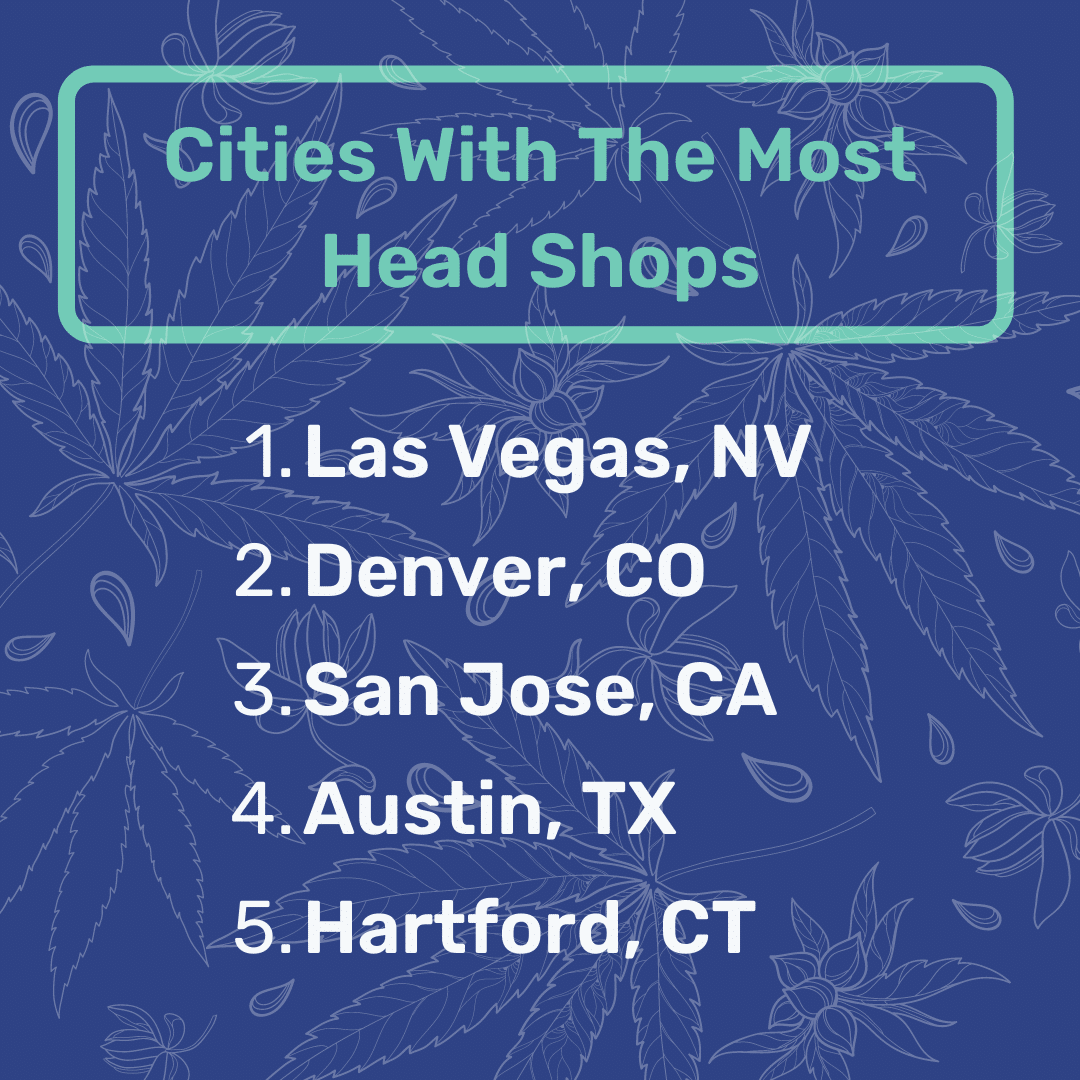  |
  |
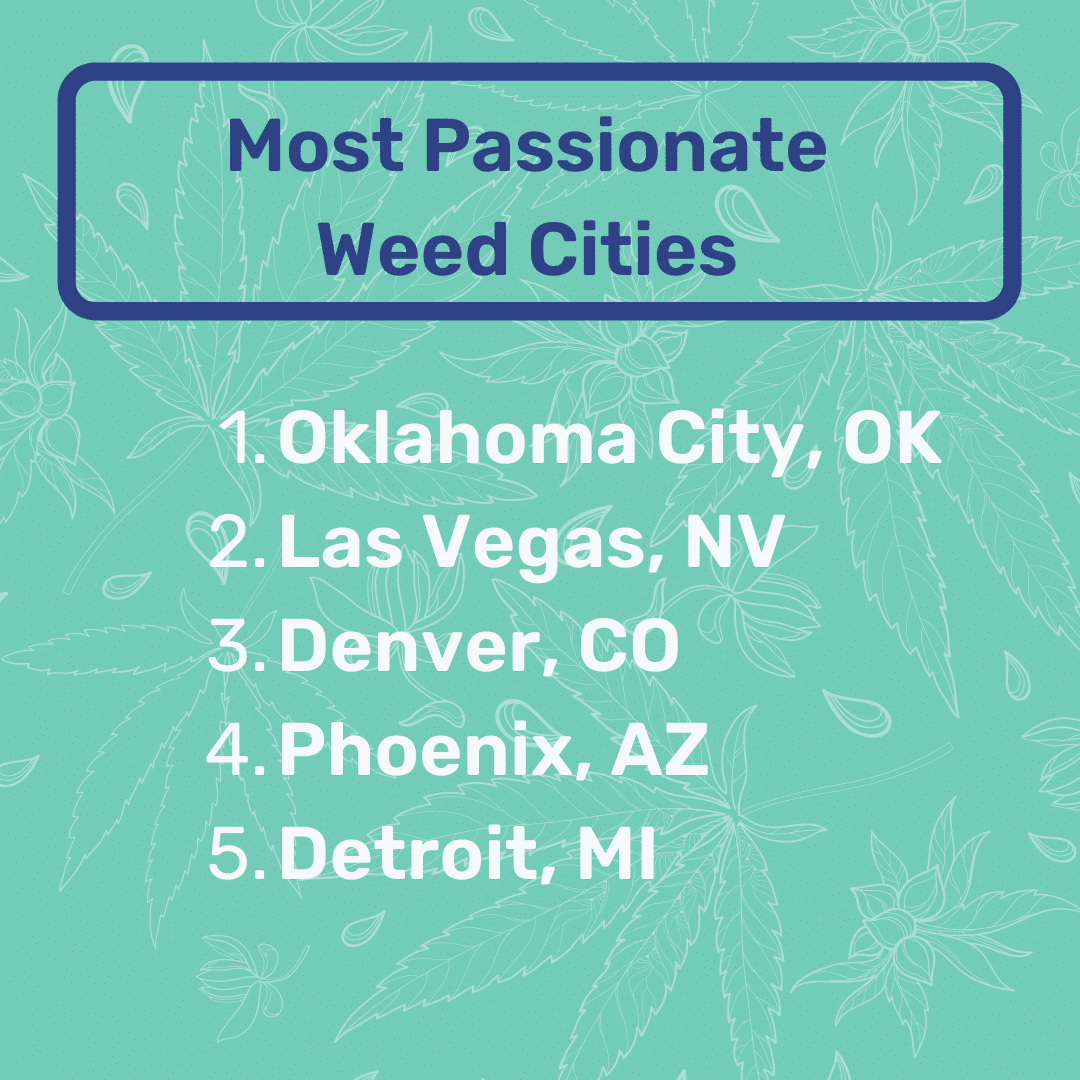  |
  |
  |
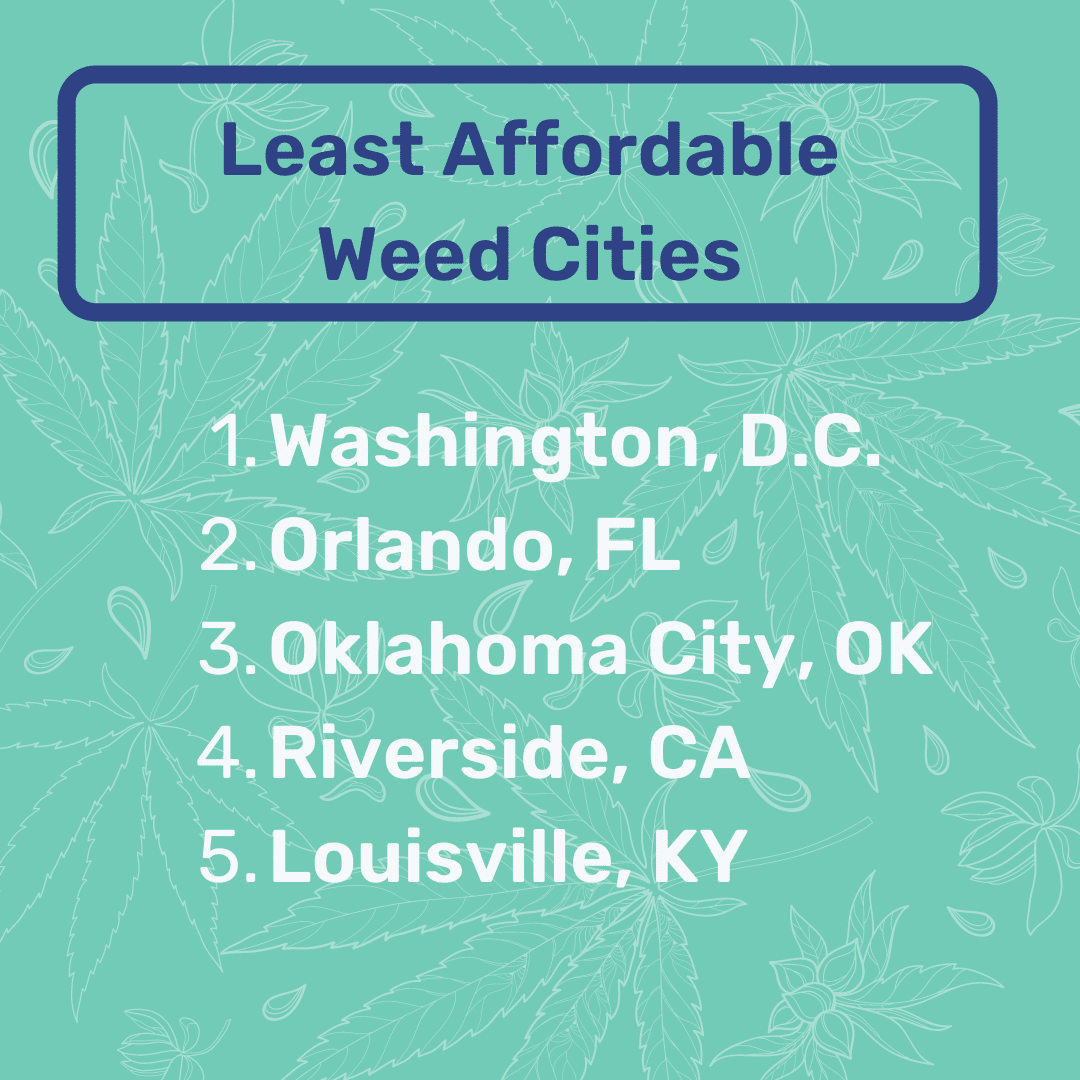  |
High and Hungry: Best Cities for the Munchies
When the munchies kick in, going to Taco Bell is a no-brainer. The fast-food restaurant has plenty of haters, but it’s the top fast-food destination for stoners, beloved for its late-night hours, easy access, and cheap menu items for as little as $1.
Plus, T-Bell is a master of outside-the-bun eating that late-night customers want, especially when they’re high. Taco Bell has the go-to snacks to satisfy any craving, whether it’s the Doritos Locos Taco or the burrito-quesadilla mashup.
With 3.8 Taco Bells per 100,000 residents, Kansas City ensures stoners won’t go hungry. The metro has 63% more locations than the average city (2.3 per 100,000 residents) and nearly 350% more than Boston, the city with the lowest number of Taco Bells (0.8 per 100,000 residents).
Indianapolis has the second-highest concentration of Taco Bells with 3.7 locations per 100,000 residents, followed by Louisville, Kentucky (3.7), and Birmingham, Alabama (3.6).
In the Midwest, Taco Bell reigns supreme as the restaurant of choice after consuming marijuana. But in the Northeast, where our bottom five cities for the munchies are concentrated, stoners prefer McDonald’s.
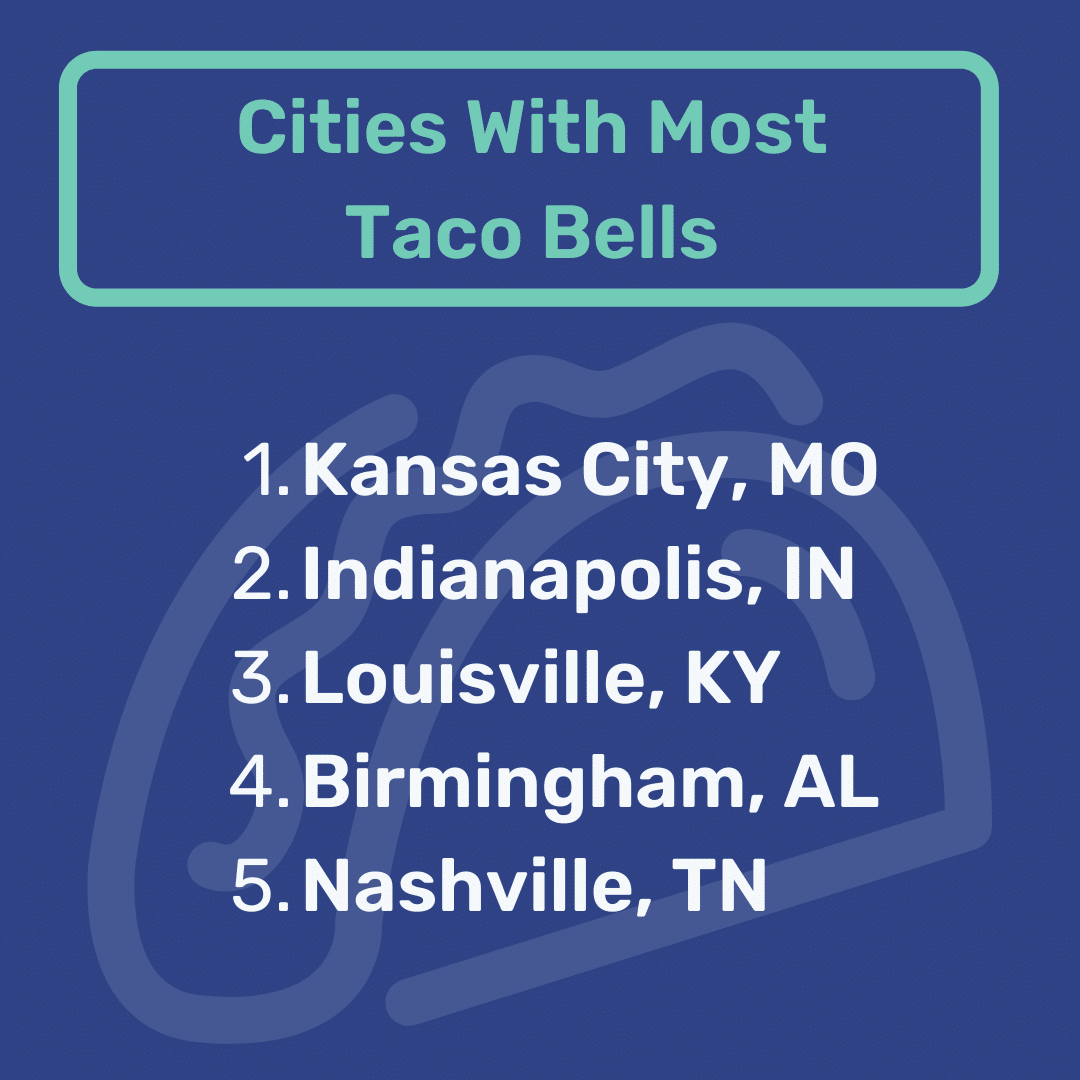  |
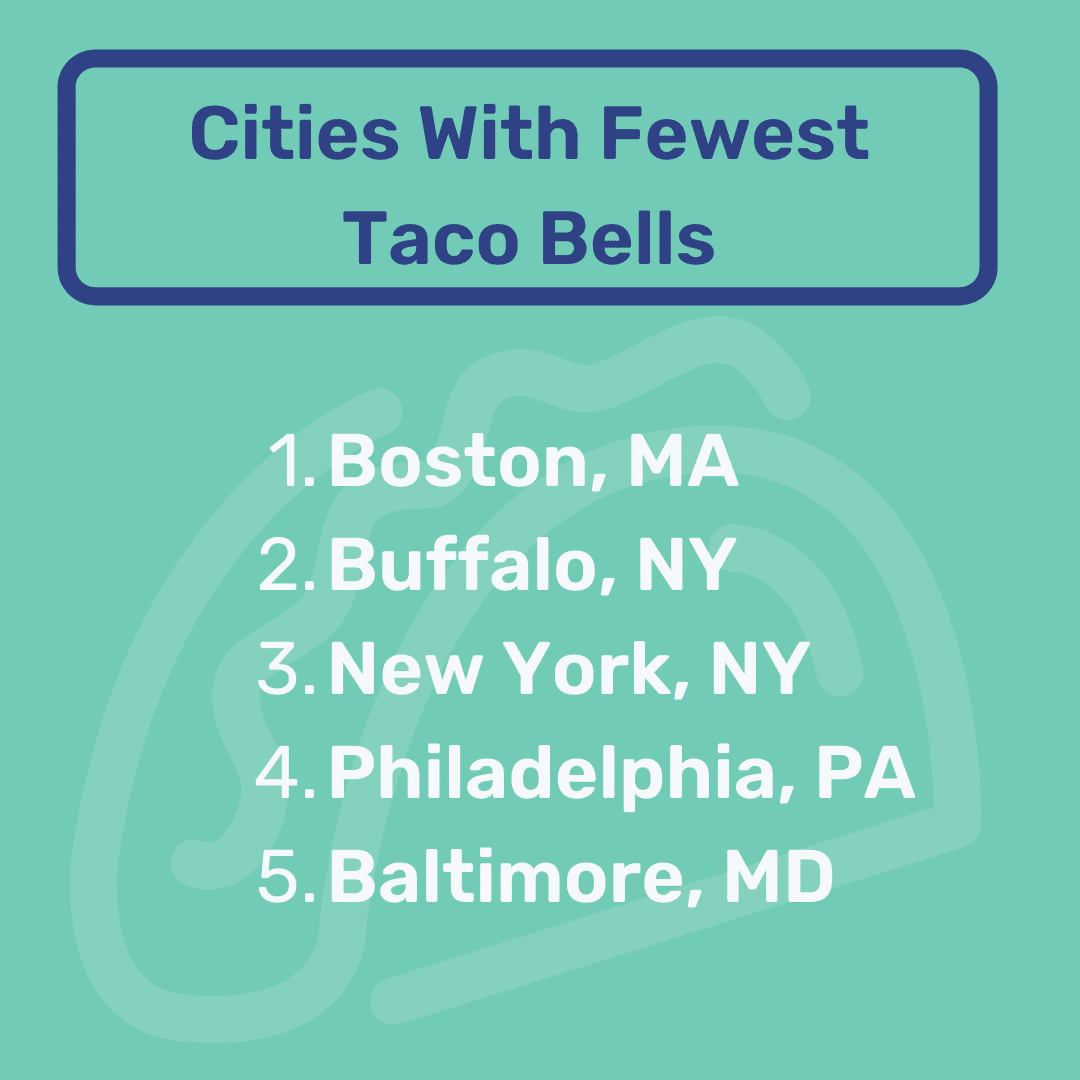  |
The 10 Worst Weed Cities
Let’s be blunt, not every city is friendly to stoners, and these 10 metros stood out as the least welcoming:
- Washington, D.C.
- Charlotte, North Carolina
- Raleigh, North Carolina
- Memphis, Tennessee
- Milwaukee, Wisconsin
- Dallas, Texas
- Atlanta, Georgia
- Houston, Texas
- Louisville, Kentucky
- Nashville, Tennessee
All together, these metros have little passion for pot based on Google Trends ratings that show they search for marijuana-related terms 37% less than the national average. They also have less variety, with 88% fewer dispensaries (0.2 per 100,000 residents) and 28% fewer head shops (0.6 per 100,000 residents) than the average city. Additionally, residents spend about 4.2% of their annual income on weed, compared to 3.7% in the average city.
Marijuana is illegal for recreational use in all of our bottom 10 cities except Washington, D.C. — our bottom city. However, recreational marijuana sales are prohibited within city limits, resulting in 11% fewer dispensaries (1.2 per 100,000 residents) and 15% fewer head shops (0.7 per 100,000 residents) than the average city.
D.C. residents also pay the highest average price for weed at $597 an ounce — 87% more than the national average. If bought once a quarter for a year, Washingtonians would spend 5.7% of their annual income on weed, compared to just 3.7% in the average city.
Methodology
Real Estate Witch compared the 50 most populous U.S. metro areas across 12 metrics, listed below. Each metric was normalized and graded on a 100-point scale. The combined weighted average of each score determined the overall “weed city” score upon which the final ranking was based.
In cases where data sets included only cities, the city data was combined and weighted by population within the overall metro in which the city belonged. In cases where data sets included only counties, county data was crosswalked with metropolitan data. In cases where data sets included only states, the state where the largest portion of the metro is located was used.
The metrics used are as follows:
- Legality of marijuana
- Google Trends data for 13 common marijuana terms
- Price of 1 ounce of high-quality and 1 ounce of medium-quality marijuana every three months as a percentage of annual income
- Price of 1 ounce of high-quality weed
- Price of 1 ounce of medium-quality weed
- Number of dispensaries per 100,000 residents within 25 miles
- Number of head shops per 100,000 residents within 25 miles
- Number of Taco Bells per 100,000 residents
- Number of local hiking trails according to the AllTrails database
- Number of music festivals within 100 miles
- Number of small concert venues per 100,000 residents within 25 miles
- Number of movie theaters per 100,000 residents within 25 miles
About Real Estate Witch
You shouldn’t need a crystal ball or magical powers to understand real estate. Since 2016, Real Estate Witch has demystified real estate through in-depth guides, honest company reviews, and data-driven research. In 2020, Real Estate Witch was acquired by Clever Real Estate, a free agent-matching service that has helped consumers save more than $82 million on realtor fees. Real Estate Witch’s research has been featured in CNBC, Yahoo! Finance, Chicago Tribune, Black Enterprise, and more.
More Research From Real Estate Witch
How Legalizing Recreational Marijuana Impacts Home Values: In states where marijuana is legal, home values increased by $6,338 more between April 2017 and April 2021. Find out how much your home may be worth.
New Must-See Clever Real Estate Reviews: Moving to a state where weed is legal? Clever’s free service can match you with a low-commission Realtor to help you save thousands in listing fees. Read what Clever customers have to say!
Top 12 Best For Sale By Owner Websites: Discover the best FSBO websites so you can save money on your home sale without dipping into your budget for weed.


